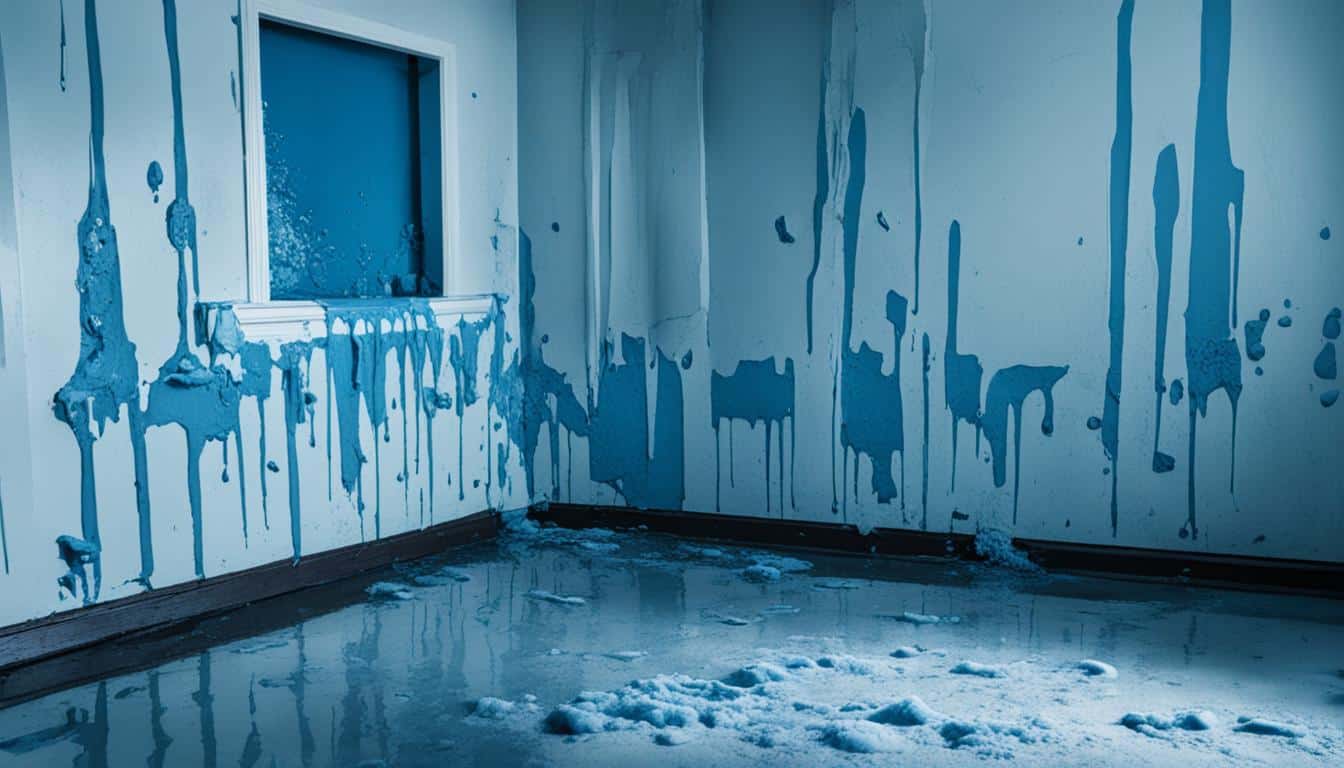Water, vital for life, can also silently damage homes. It starts subtly but quickly becomes a big problem. The real question is: how long does it take for water to cause structural damage?
As soon as water finds a way in, it threatens what we value. In just a few hours, beloved items and building parts are at risk. They start to change shape and get damaged, showing us something is wrong. Days later, warning signs turn into a serious situation with wood rot and dangerous mold.
After a week, a home fights harder to stay together. Things like windows and floors start to show the damage. This is when urgent action is key. Waiting only makes the problem worse and more expensive to fix. Those who care about their homes must act fast. Within 24 to 48 hours, quick action can save you from a big renovation.
Key Takeaways
- The critical response window to prevent extensive water-induced damage is within 24 to 48 hours of initial exposure.
- Wood, paint, metal, and drywall are especially susceptible to damage in the early stages of water exposure.
- Long-term neglect can lead to significant structural compromise, health risks, and escalated repair costs.
- Proactive measures and damage prevention strategies are crucial in mitigating the impact of water incidents.
- Understanding the property damage timeline is essential for homeowners to prevent and address water damage effectively.
The Immediate Impact of Water Damage
Water damage can swiftly affect a building’s structure and safety. It doesn’t just touch the surface, but it goes deep. It starts a process of deterioration that’s costly to fix. In a few hours, things like doors and drywall can swell because of the water they absorbed.
Metals also suffer, quickly losing their shine. They lose strength and beauty. Painted surfaces also start to peel because of the water. At this stage, what’s done can affect the whole damage and repair costs.
- Quick identification of the water source and its immediate cessation
- Assessment of all impacted areas to determine the scope of damage
- Deployment of drying strategies to mitigate further absorption
- Clean-up efforts that involve removing water and disinfecting surfaces to prevent mold growth
The impacts of water damage include creating a place where bacteria and mold thrive. These can start in the first day after water exposure. Taking quick action is key to limit both the visible harm and health dangers. Early steps protect the property and the people in it. This highlights the importance of acting fast when water damage happens.
Swift Development of Mold and Mildew
Mold and mildew can start growing within 24 to 48 hours of water damage. It grows fast and can damage property like carpets and drywall. It also makes furniture less safe to use. This often means hiring professionals to fix the problem. Beyond property damage, Mold and Mildew can be a danger to our health. It can cause breathing issues and skin problems like asthma and eczema.
It’s crucial to act fast after water damage to stop Mold and Mildew. They can weaken buildings and harm people. Here’s why quick action is important:
- It helps prevent mold from spreading through vents and making people sick.
- The air becomes unsafe to breathe because of mold and mildew spores.
- Your home becomes less valuable, and repairs are expensive.
Dealing with water damage right away can reduce these risks a lot. Drying things out quickly, using dehumidifiers, and getting help from restoration pros are key. This helps keep your home safe from Mold and Mildew effects.
Water Damage Timeline: The First 24 to 48 Hours
When water first enters, the first 24 to 48 hours are key. This period, known as the critical response period, is crucial. It’s important for noticing early water damage signs and acting fast to reduce long-term harm to your home.
Knowing what happens in these early stages is important. It can save you from big, expensive repairs later.
Here’s why acting quickly is important after water damage:
- Detection of Early Water Damage Signs: It’s crucial to spot signs like water stains, wood swelling, or a musty smell early. This can stop the damage from getting worse.
- Initial Water Damage Effects: Water starts to be soaked up by materials like drywall and floors. This damages their strength and looks.
- Critical Response Actions: You must quickly remove the water and start drying to prevent mold and more damage.
Acting within the critical response period stops a domino effect of harm. This harm could cause deep problems and a weak structure. So, knowing early water damage signs and the effect of initial water damage is crucial. It helps keep your home safe from lasting harm.
Escalating Costs with Progressive Damage Over Days
The longer water damage goes unfixed, the more its financial impact and restoration costs rise. This trend affects property owners’ wallets and the building’s structure. So, it’s crucial to act fast.
Not fixing water damage quickly brings severe consequences. Wood warps, while paint and wallpaper peel off walls. Metal items corrode fast, becoming irreparable.
These issues show the extended water damage consequences over just a few days. Mold and mildew, although hidden at first, thrive. Their growth poses health risks and can lead to future expensive repairs.
If prompt action isn’t taken, expenses can spiral. They might even surpass the property’s value. Insurance might not fully cover these costs. Plus, living in a damaged home could be dangerous.
Dealing early with water damage saves a lot of trouble. It prevents big hits to your finances and health.
Understanding Water’s Long-Term Effects on Structural Integrity
When water gets into a building for a long time, it causes more than just a quick mess. Long-term water damage silently harms the structure. This leads to big, and sometimes, permanent harm. We will talk about how water hurts the building’s parts and why finding it early is crucial. Plus, we’ll mention how regular care helps stop structural compromises.
Moisture can soak deep into a building over the years. This brings many structural problems:
- It causes walls and foundations to crack, showing water and possible instability.
- Wooden beams and joists start to rot and decay, due to being wet for too long.
- It makes metal parts rust, weakening the building’s strong points.
This kind of damage makes a building likely to fall apart. It also makes it worth less money. Unfortunately, people often don’t see long-term water damage until it’s a big problem. Then, fixing it takes a lot of time and money.
Plus, the bad impact of water getting in is not just on the outside:
- It can mess up electrical systems, which is very dangerous.
- Wet insulation becomes less useful and causes a mold-growing space.
- It can also open the door to more pest problems.
Ignoring at first can lead to big trouble. Spotting and dealing with long-term water damage is key. It keeps your place safe, useful, and valuable. Homeowners and managers need to always check for these warning signs. They should be ready to fix things quickly to steer clear of lasting effects and structural compromises.
Responsiveness to Water Incidents: The Key to Minimizing Damage
When it comes to water incidents, acting fast is extremely important. Quick and smart responses can lessen how much damage your property takes. This part looks at why rapid action is crucial in water damage cases.
Minimizing water damage and getting back on your feet quickly needs everyone to work together. Waiting to act can make problems much worse, costing more money and possibly causing health issues. This affects both the building’s strength and the people living or working there.
- Engaging professional restoration services promptly.
- Using advanced technology to assess and address the damage.
- Maintaining clear and open communication lines with restoration teams.
Responding quickly to water incidents and controlling damage keeps your property better and safer. It aims to stop things from getting worse, like more mold or other dangerous things, and avoid bigger problems.
- Assessment of the water damage extent immediately upon discovery.
- Implementation of water removal and drying processes without delay.
- Regular monitoring to ensure the environment remains safe and free from mold growth.
Learning how to deal with water issues is also about preventing future harm. Acting firmly and right away is crucial in lessening the damage and keeping restoration costs down. It’s about being smart to keep your place safe and secure.
Preventative Strategies and Smart Detection Systems
For property managers and homeowners, using water damage prevention is key. It’s critical to keep up with leak detection systems. These systems find issues before they become big problems.
Leak detection systems are a must-have. They catch leaks early and alert you instantly. Property managers should follow these steps for better prevention:
- Regularly inspect roofs, gutters, and downspouts to ensure they are not blocked and are directing water away from the foundation.
- Check plumbing systems annually to catch leaks early and repair any damage to pipes or connections.
- Install intelligent leak detection devices that can provide instant alerts to your mobile device or computer.
Also, insulating pipes and waterproofing basements are smart moves. These practices, combined with tech, stop damage. They protect the property for a longer time. This guarantees peace of mind for all.
Conclusion
Dealing with the effects of water damage needs a quick and smart response from all parties involved. Homeowners, property managers, and landlords must act fast. Fixing the issue in 24 to 48 hours can stop major damage. Water damage might not show at first, but taking fast steps can reduce the harm.
Getting help from skilled professionals is key. They have the equipment and know-how to prevent more damage and any health risks. Along with their help, good care of your property and using the latest technology to detect water early can keep your place safe.
By following these tips, property owners can lower the risk of water damage. Acting quickly and being prepared can protect your home or building. It saves the property’s value and those who live in it. Remembering and applying these guidelines gives peace of mind against water damage.






